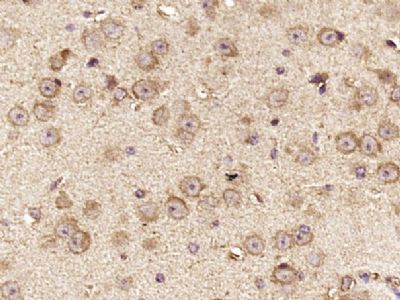Rho guanine exchange factor 16 Polyclonal Antibody
Purified Rabbit Polyclonal Antibody (Pab)
- SPECIFICATION
- CITATIONS
- PROTOCOLS
- BACKGROUND

Application
| WB, IHC-P, IHC-F, IF, ICC, E |
|---|---|
| Primary Accession | Q5VV41 |
| Host | Rabbit |
| Clonality | Polyclonal |
| Calculated MW | 80 KDa |
| Physical State | Liquid |
| Immunogen | KLH conjugated synthetic peptide derived from human RHEBL1 |
| Epitope Specificity | 151-250/709 |
| Isotype | IgG |
| Purity | affinity purified by Protein A |
| Buffer | 0.01M TBS (pH7.4) with 1% BSA, 0.02% Proclin300 and 50% Glycerol. |
| SUBCELLULAR LOCATION | Cytoplasm. |
| SIMILARITY | Contains 1 DH (DBL-homology) domain. Contains 1 PH domain. Contains 1 SH3 domain. |
| SUBUNIT | Interacts with ELMO2, EPHA2, RAC1 and RHOG; mediates activation of RAC1 by EPHA2. Interacts with TAX1BP3 (via PDZ domain). May interact with CDC42; stimulated by HPV16 E6. |
| Important Note | This product as supplied is intended for research use only, not for use in human, therapeutic or diagnostic applications. |
| Background Descriptions | Although the specific function of this protein is not known yet, it is thought to be involved in protein-protein and protein-lipid interactions. [provided by RefSeq, Jul 2008] |
| Gene ID | 27237 |
|---|---|
| Other Names | Rho guanine nucleotide exchange factor 16, Ephexin-4, ARHGEF16, EPHEXIN4, NBR |
| Dilution | WB=1:500-2000,IHC-P=1:100-500,IHC-F=1:100-500,ICC=1:100-500,IF=1:100-500,ELISA=1:5000-10000 |
| Storage | Store at -20 ℃ for one year. Avoid repeated freeze/thaw cycles. When reconstituted in sterile pH 7.4 0.01M PBS or diluent of antibody the antibody is stable for at least two weeks at 2-4 ℃. |
| Name | ARHGEF16 |
|---|---|
| Synonyms | EPHEXIN4, NBR |
| Function | Guanyl-nucleotide exchange factor of the RHOG GTPase stimulating the exchange of RHOG-associated GDP for GTP. May play a role in chemotactic cell migration by mediating the activation of RAC1 by EPHA2. May also activate CDC42 and mediate activation of CDC42 by the viral protein HPV16 E6. |
| Cellular Location | Cytoplasm. |

Thousands of laboratories across the world have published research that depended on the performance of antibodies from Abcepta to advance their research. Check out links to articles that cite our products in major peer-reviewed journals, organized by research category.
info@abcepta.com, and receive a free "I Love Antibodies" mug.
Provided below are standard protocols that you may find useful for product applications.
If you have used an Abcepta product and would like to share how it has performed, please click on the "Submit Review" button and provide the requested information. Our staff will examine and post your review and contact you if needed.
If you have any additional inquiries please email technical services at tech@abcepta.com.













 Foundational characteristics of cancer include proliferation, angiogenesis, migration, evasion of apoptosis, and cellular immortality. Find key markers for these cellular processes and antibodies to detect them.
Foundational characteristics of cancer include proliferation, angiogenesis, migration, evasion of apoptosis, and cellular immortality. Find key markers for these cellular processes and antibodies to detect them. The SUMOplot™ Analysis Program predicts and scores sumoylation sites in your protein. SUMOylation is a post-translational modification involved in various cellular processes, such as nuclear-cytosolic transport, transcriptional regulation, apoptosis, protein stability, response to stress, and progression through the cell cycle.
The SUMOplot™ Analysis Program predicts and scores sumoylation sites in your protein. SUMOylation is a post-translational modification involved in various cellular processes, such as nuclear-cytosolic transport, transcriptional regulation, apoptosis, protein stability, response to stress, and progression through the cell cycle. The Autophagy Receptor Motif Plotter predicts and scores autophagy receptor binding sites in your protein. Identifying proteins connected to this pathway is critical to understanding the role of autophagy in physiological as well as pathological processes such as development, differentiation, neurodegenerative diseases, stress, infection, and cancer.
The Autophagy Receptor Motif Plotter predicts and scores autophagy receptor binding sites in your protein. Identifying proteins connected to this pathway is critical to understanding the role of autophagy in physiological as well as pathological processes such as development, differentiation, neurodegenerative diseases, stress, infection, and cancer.




